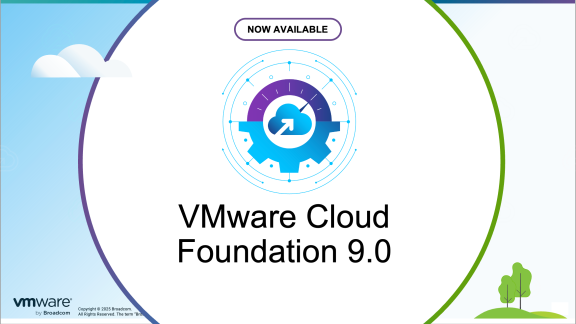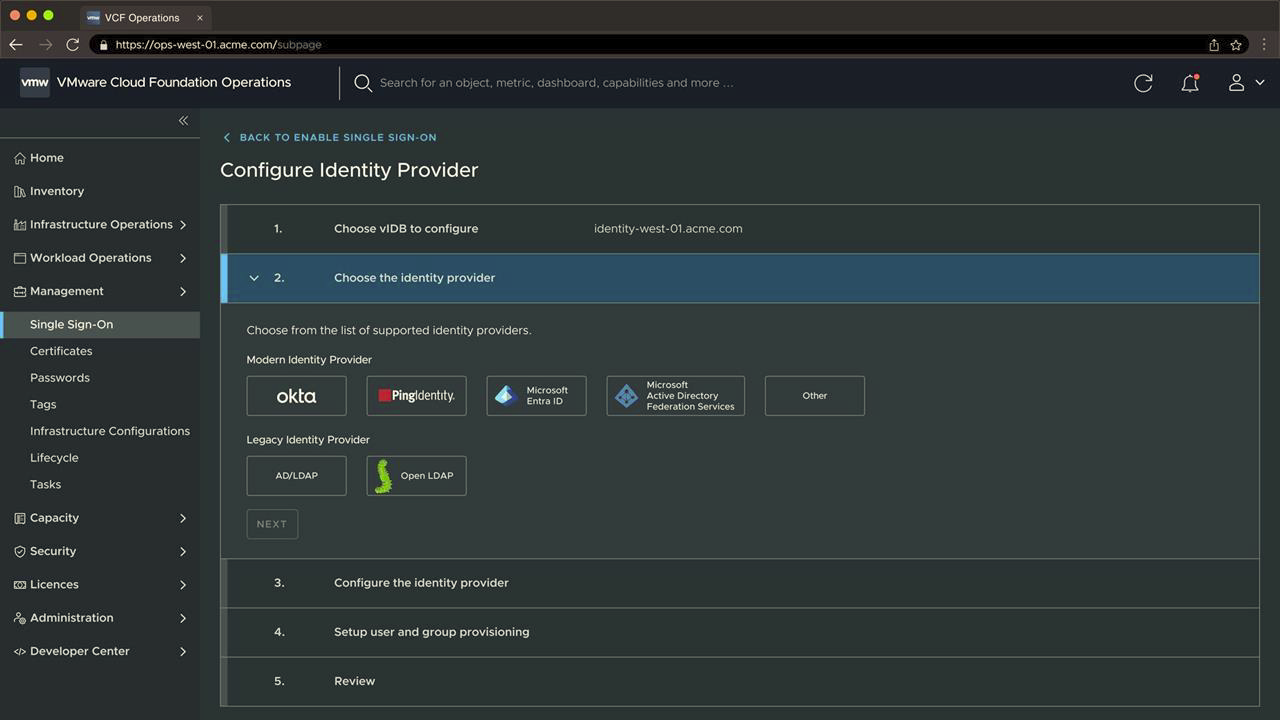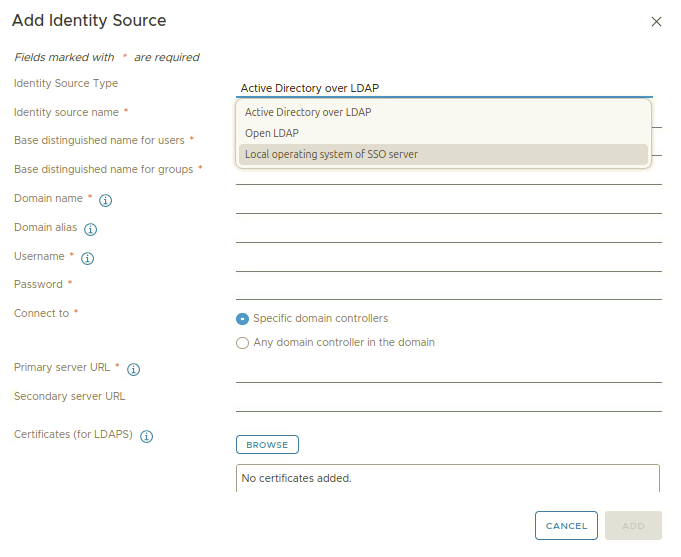Broadcom has just announced the General Availability (GA) of VMware Cloud Foundation (VCF) 9.0 and the General Availability (GA) of VMware vSphere Foundation (VVF) 9.0.
The best way to learn more about the new features is to try the new VMware Hands on Labs:
- What’s New with vSphere in VMware Cloud Foundation 9.0 (HOL-2630-01-VCF-L)
- What’s New in VMware Cloud Foundation 9.0 – Platform (HOL-2610-01-VCF-L)
- What’s New in VMware Cloud Foundation 9.0 – Automation (HOL-2610-02-VCF-L)
- What’s New in VMware Cloud Foundation 9.0 – Operations (HOL-2610-03-VCF-L)
- Unifying VM and Kubernetes Management with vSphere Supervisor in VMware Cloud Foundation 9.0 (HOL-2633-01-VCF-L)

The Fundamental Shift in VCF 9.0
Every major version of VMware Cloud Foundation has pushed automation farther up the stack. Version 9.0 draws a clear line in the sand: private-cloud operations and private-cloud consumption are now the central part of the product while operating on top of our core innovation that our customers have learned to love and rely on.
At the heart of this release is a unification of context. Whether you are troubleshooting a capacity warning, onboarding a new tenant, or publishing an infrastructure template for CI/CD, you work from the same policy model, the same API surface, and the same lifecycle engine. That consistency trims learning curves for operators, removes friction for developers, and—crucially—reduces the points of failure that appear when separate tools drift out of sync.
- One Interface to Private Cloud Operations – Fleet-wide health, patching, and compliance from one console, so operational decisions rely on a common view of truth.
- One Interface for a Cloud Consumption Experience – Developers hit one endpoint for IaC—Terraform providers, REST APIs, or VCF Automation blueprints—without the need to juggle add-ons.
- Run VMs and Containers/K8s – Run bare-metal-fast VMs and fully-managed Kubernetes side-by-side. Integrated Argo CD and native CI/CD hooks push container code from repo to production with no external scaffolding.
- Sovereign and Secure as a Platform – Data-residency tags, geo-fencing policies, and automated certificate rotation can now be a part of every cluster spec. Sovereign doesn’t just mean on premises, it means the ability to deploy with guardrails, to understand where the data lives to be able to control it, to protect it and ensure that every cluster is constantly compliant with sovereign rules.
- Embedded Cost Control – Chargeback, showback, cost management and predictability dashboards turn resource consumption into invoice-ready numbers for each tenant or business unit. This is not simply showback – this is the ability for business leaders to budget, constraint, contract and expand infrastructure based on cost insights that are based directly on the existing deployment and correlated with consumption.
What’s new in VCF and VVF 9.0?
For more information see also: What’s new in VMware Cloud Foundation 9.0 and What’s new in VMware vSphere Foundation 9.0.
VMware Cloud Foundation Installer
VCF and VVF 9.0 setup is now simplified with a new guided, automated installation experience. The new VMware Cloud Foundation Installer, automates pre-checks and configuration, ensuring each component is deployed correctly.
Want to spin up identical environments across clusters or sites? Simply reference a JSON template to replicate environments across clusters or sites, ideal for consistent rollouts.
VCF Installer delivers the following key benefits:
- Eliminates manual installation steps, reducing deployment complexity.
- Minimizes configuration errors through embedded health checks.
- Speeds time to production so admins can focus on strategic projects.
VMware Cloud Foundation Operation
VCF Operations is your home base for day-to-day troubleshooting, deployments and overall diagnostics. It ties into all our beloved core features but it also makes things like Fleet Management – from upgrades to patching to certificate rotation incredibly easy.
VMware Cloud Foundation Operations helps organizations build, manage, operate and secure their private cloud infrastructure by deploying and maintaining its fleet-level components, providing unified visibility and enhanced performance across the workload and infrastructure stack, and helping stay compliant with regulatory standards and organizational guidelines.
VCF Operations provides a single, unified interface to build, operate and secure the private cloud, significantly enhancing the cloud admin experience and eliminating operational silos. It is purpose-built for operationalizing VCF at scale while reducing complexity and operational overhead. From infrastructure provisioning to lifecycle management, everything is centralized in a single view, enabling faster deployments, streamlined upgrades, and more predictable operations. VCF Operations empowers IT teams to focus on delivering value, rather than managing infrastructure complexity.

VCF Operations includes the following major capabilities:
- Building Cloud Infrastructure
- Lifecycle Management
- Fleet Management
- Infrastructure Operations
- Workload Monitoring and Observability
- Cost and Capacity Management
- Workload Mobility
- Security and Compliance
Advanced Memory Tiering with NVMe
RAM can be a significant cost in the data center. VMware vSphere 8.0 Update 3 has introduced NVMe memory tiering in tech preview for automatically moving cold or infrequently accessed memory pages to high-performance NVMe SSDs while keeping hot pages in DRAM. The result is a larger effective memory footprint at a fraction of the cost. Ideal for memory intensive environments such as VDI (Virtual Desktop Infrastructure), high-frequency trading engines, in-memory analytics, and JVM-heavy apps.
Now this feature it’s available in GA both in VCF and VVF 9.0.
Advanced Memory Tiering with NVMe delivers the following key benefits:
- Increases workload density, consolidating more VMs per host.
- Reduces DRAM requirements, lowering hardware, power, and cooling expenses.
- Achieve up to 38% lower memory & server TCO (Total Cost of Ownership).
Faster vMotion migration with virtual GPU
AI/ML workloads demand uninterrupted GPU access and any pause can derail training or inference. VMware vSphere Foundation 9.0 accelerates vMotion for GPU-backed VMs by streaming GPU memory up using Fast Suspend/Resume. VMware VCF and VVF 9.0 vMotion is now up to 6x faster for GPU powered workloads, resulting in zero downtime during VM lifecycle events running GPUs.

GPU vMotion optimization key benefits:
- Increased uptime for AI/ML workloads.
- Maintains near-peak performance during host maintenance.
- Ensures SLAs for GPU-driven applications remain intact.
Increase support for “Monster” VMs
VCF and VVF 9.0 raise the bar on VM scale, you can now configure a single VM with up to 960 CPUs, with native support for the latest AMD Zen 5 and Intel Granite Rapids processors. Whether you’re running in-memory databases, large-scale container platforms, or enterprise analytics, VCF 9.0 lets you consolidate these “monster” workloads onto a single host.
In order to benefit the new features, you need to use the new virtual hardware 22!
Support for “Monster” VMs key benefits:
- Simplifies capacity planning by reducing the need to share across servers.
- Enables large-scale workloads to run on a single host, cutting operational overhead.
- Provides performance gains from next-gen CPU architecture.
Improved Automation and Standardized APIs
Standardized APIs and consistent SDKs across VMware vSphere Foundation components. Open API 3.0 support for vCenter and vSAN APIs. Deliver a consistent automation experience across all VCF and VVF components. Make automation of services easy and simplify initial setup and configuration for developers to use these APIs and SDKs. Enable support of legacy and new applications to access these services.
Automation with Open API 3.0 and Unified SDK key benefits:
- Unified automation, one SDK and OpenAPI 3.0 simplify provisioning operations.
- Accelerate automation with scripts that continue working across upgrades, enabled by Open API specs and seamless SDK regeneration.
- Enable effortless expansion by extending without learning new APIs.
vSAN Global Deduplication
Flash remains the cost driver in most private clouds. Global block-level dedupe now spans clusters, not just disks, carving out duplicate data once and sharing the savings everywhere else. You protect and serve larger datasets on the same flash footprint—and you do it without the performance penalties typical of post-process dedupe engines.
vSAN to vSAN Replication
New data protection workflows are now built into vSAN Express Storage Architecture (ESA), eliminating the need for separate replication tools. With VCF and VVF 9.0, you can use vSAN data protection workflows to replicate snapshots asynchronously between two vSAN ESA datastores. This integrated vSAN-to-vSAN replication allows you to define and manage recovery policies directly within the vSAN cluster, using immutable snapshots and VM-level replication, without requiring additional infrastructure or matching hardware at both sites.

vSAN-to-vSAN replication delivers the following key benefits:
- Simplified operations with policy-based protection. Easily assign protection policies via protection groups to one or multiple VMs.
- Achieve rapid and efficient recovery to minimize data loss and downtime during site-level failures with near-continuous protection.
- Built-in resilience, ensures critical workloads remain available with integrated, VM-level failover and failback capabilities.
Traffic Separation for vSAN Storage Clusters
In VMware VCF and VVF 9.0, vSAN storage cluster (formerly known as vSAN Max) traffic separation creates a dedicated network pipeline for storage operations. In testing across real-world workloads, this delivers more IOPS without new hardware. When a node fails, storage traffic remains isolated, providing predictable performance as your cluster scales.

vSAN storage clusters traffic separation delivers the following key benefits:
- Boost vSAN storage cluster performance by up to 25%.
- Reduces performance-related tickets and improves overall SLAs.
- Use existing investment for compute network traffic.
Enhanced Unified Storage Dashboard
VMware VCF consolidates telemetry from core infrastructure into a single control plane. In version 9.0 an enhanced unified storage dashboard delivers real-time visibility into vSAN, SAN, and NAS environments—eliminating the need for multiple monitoring tools. Built-in machine learning analytics and intelligent alerts help detect anomalies early, while integrated diagnostics streamline root cause analysis.
Enhanced support for vSAN/HCI performance diagnostics enables users to run targeted performance tests on clusters, with actionable insights and recommendations to quickly identify and resolve performance issues.
Enhanced unified storage dashboard delivers the following key benefits:
- Unified view across all storage types, eliminating the need to switch between multiple consoles.
- Live health and performance metrics for faster issue detection and troubleshooting.
- Predictive insights help prevent downtime and improve SLAs.
Comprehensive security at every layer
VMware VCF and VVF 9.0 ensure data and infrastructure are protected with built-in encryption, secure configurations, and advanced compliance features like FIPS and TLS 1.3.
By enforcing only AEAD (Authenticated Encryption and Associated Data) ciphers and forward secrecy by default, it eliminates legacy protocols, compliance is automatic. This also cuts setup time compared to TLS 1.2 and delivers faster, more responsive HTTPS connections, while protecting each session with a unique encryption key.

Secure by default with TLS 1.3 enabled key benefits:
- Modern encryption standards reduce attack surface and simplify audits.
- FIPS 140-2 validated encryption gives you enterprise-grade trust.
- Administrators can roll out secure communications quickly across the infrastructure.
vSphere Lifecycle Management (vLCM) Enhancements
VMware vSphere Lifecycle Manager (vLCM) now supports composite cluster images, allowing customers to manage mixed vendor clusters with multiple server models and hardware types in a single cluster. Up to four additional image configurations per cluster can be defined per cluster, each with its own unique vendor add-ons, firmware, and hardware support managers (HSMs), while maintaining a consistent ESXi base version.
This enhancement gives IT teams the flexibility to scale and modernize infrastructure without hardware lock-in, simplifies lifecycle management, and ensures consistent, compliant updates across diverse environments.
vLCM enhancements delivers key benefits:
- Uniform patch workflows ensure compliance and maximize uptime.
- Simplifies maintenance windows by reducing patch driven surprises.
- Flexible hardware expansion allows adding new server models to existing clusters without full hardware refreshes or rearchitecting.
ESXi Live Patching
VMware VCF and VVF extend the Live Patching capability first introduced in VMware vSphere 8.0 Update 3, enabling faster response to security threats without impacting your operations. Whether it’s the ESXi host, vSAN, or the core vmkernel, these essential updates are delivered within a defined SLA, ensuring your infrastructure remains compliant and secure—without the downtime.
Security Live Patching for ESXi key benefits:
- Apply critical patches, no need to reboot or evacuate VMs, keep workloads running.
- Fast remediation with express patches, rapid delivery of security fixes within a defined SLA.
- Built-in UI guidance for safe operations, helps troubleshoot issues or switch to maintenance mode if needed.
Asynchronous Supervisor patching
In VMware VCF and VVF, the vSphere Supervisor provides a control plane on which a robust set of services can be provisioned to support building modern workloads using containers and VMs.
With 9.0 release, the Supervisor clusters can be patched and updated independently of vCenter. This allows for more rapid delivery of new Supervisor versions and access to the newest functionality and security patches.

Asynchronous Supervisor Releases deliver the following key benefits:
- Faster delivery of Supervisor releases and new functionality.
- Non-disruptive operations, update the Supervisor independently of vCenter.
- Flexible update options, choose between Broadcom depot or offline Content Library.
Centralized and automated license management
With the release of VCF and VVF 9 you will no longer need to manage license keys, instead a new license file is used to license all the SDDC components. This change helps to make licensing more secure as license files are specific to each customer and use a digital signature to both validate and protect the license.
What is missing?
One year ago, VMware releases the Beta release of VMware Host Client… but the ESXi 9.0 host UI seems almost similar to the previous version.
Also the new version does not include any improvment of VMware vVols (Virtual Volumes) because capabilities will be deprecated beginning with the release of VMware Cloud Foundation (VCF) version 9.0 and VMware vSphere Foundation (VVF) version 9.0 and will be fully removed in VCF/VVF 9.1. As a result, all vVol certifications for VCF/VVF 9.0 will be discontinued effective immediately.
VMware vSphere 8.0 Update 3 was the final release to support Integrated Windows Authentication (IWA) in VMware SSO as explained in the VMware KB 314324 (Removal of Integrated Windows Authentication). Version 9.0 does not include it anymore. Note that also all IWA related functionalities like Windows Session Authentication (SSPI) have been removed!












